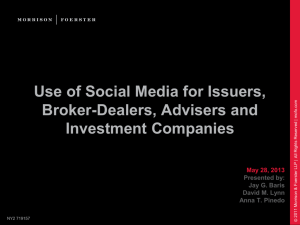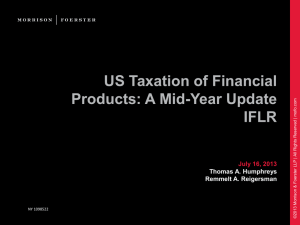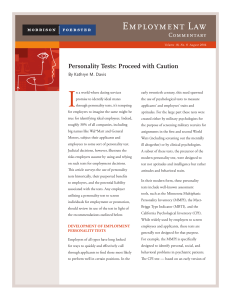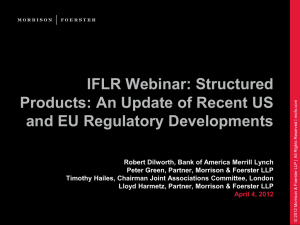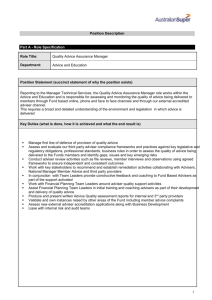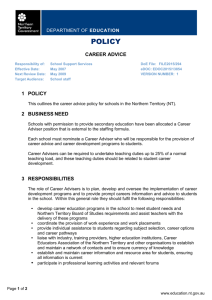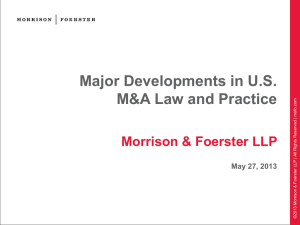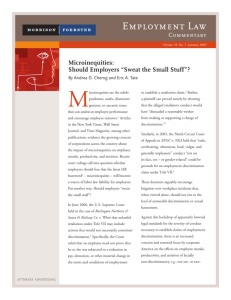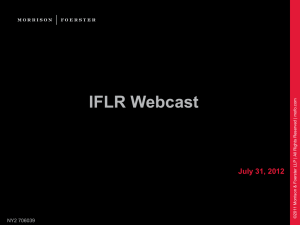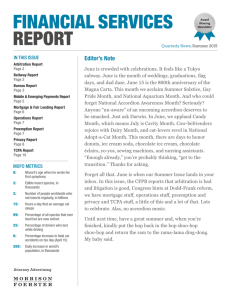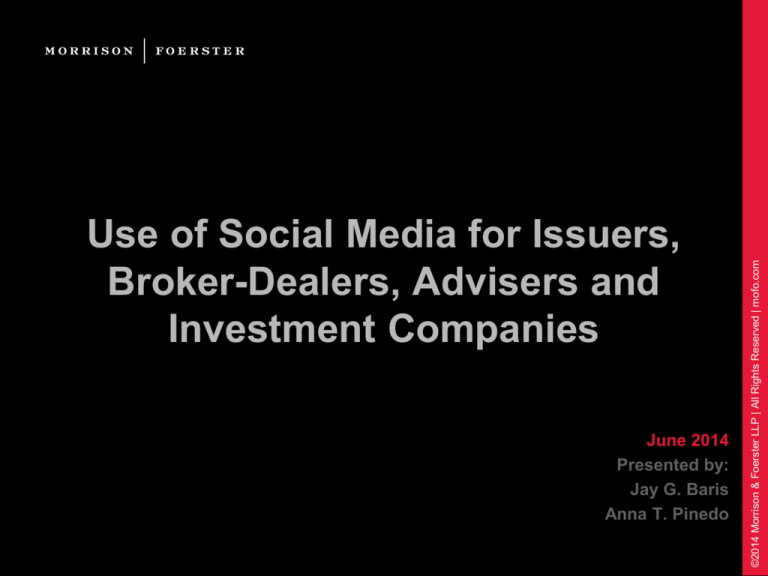
June 2014
Presented by:
Jay G. Baris
Anna T. Pinedo
©2014 Morrison & Foerster LLP | All Rights Reserved | mofo.com
Use of Social Media for Issuers,
Broker-Dealers, Advisers and
Investment Companies
Caveat
This outline is for informational purposes only and does not constitute
legal advice or create an attorney-client relationship
Consult your own attorney for legal advice on the issues discussed in
this outline
IRS Circular 230 Disclosure
To ensure compliance with the requirements imposed by the IRS, we inform you
that any tax advice contained in this communication was not intended or written to
be used, and cannot be used, for the purpose of (i) avoiding tax-related penalties
under the Internal Revenue Code or (ii) promoting, marketing, or recommending to
another party any matters addressed herein
This outline may constitute attorney advertising
This is MoFo.
2
Agenda
Today we will provide an overview of the issues that may arise in
connection with the use of social media:
By issuers for their ongoing communications
By issuers in connection with securities offerings
By broker-dealers and non-broker-dealers in the context of securities offerings
By broker-dealers generally
By investment companies and investment advisers
This is MoFo.
3
Social Media and Issuers
This is MoFo.
4
Social Media and Issuers
Considerations with the use of social media by public companies:
Antifraud considerations with social media communications
Social media considerations under Regulation FD
The use of social media during the offering process
Social media has been embraced by companies for many purposes,
but there has been uncertainty as to the federal securities law
implications of using social media to communicate information to
investors
This is MoFo.
5
Antifraud Considerations
Companies must consider the potential for insider trading and
market manipulation concerns arising from the use of social media
Considerations with the rapid and often informal nature of social
media communications
Employees acting as company representatives cannot avoid
responsibility for material misstatements or omissions by
purporting to speak in individual capacities
Does the 140-character limit of a Tweet create a heightened
potential for a material misstatement or omission?
This is MoFo.
6
Antifraud Considerations (cont’d)
The SEC has said that a company is not responsible for statements
that third parties post on a company-sponsored website unless the
company had adopted or endorsed the statements, nor does a
company have any obligation to correct a misstatement made by a
third party
A company can be held liable for third party information to which it
hyperlinks from its website and which could be attributable to the
company through concepts of:
Entanglement; or
Adoption
This is MoFo.
7
Regulation FD
Regulation FD provides:
Whenever a public company, or any person acting on its behalf,
discloses material nonpublic information to certain enumerated
persons, the company must disclose that information either
simultaneously (in the case of intentional disclosures) or promptly
(in the case of unintentional disclosures)
This is MoFo.
8
Regulation FD Guidance
On April 2, 2013, the SEC issued guidance which indicates that
social media channels could under certain conditions be used by
public companies to disseminate material information, without
violating Regulation FD
Report of Investigation Pursuant to Section 21(a) of the Securities Exchange Act
of 1934: Netflix, Inc., and Reed Hastings, Release No. 34-69729 (April 2, 2013)
The SEC emphasized that companies should apply the guidance
from its 2008 interpretive release regarding the disclosure of
material information on company websites when analyzing whether
a social media channel is in fact a “recognized channel of
distribution,” including the guidance that investors must be provided
with appropriate notice of the specific channels that a company will
use in order to disseminate material nonpublic information
This is MoFo.
9
SEC Guidance on Use of Websites
In Release No. 34-58288 (August 1, 2008), the SEC revisited its
guidance on the use of technology to disseminate information, and
provided three considerations for determining whether information
posted on a corporate website is considered “public” such that a
subsequent communication will not be deemed selective disclosure
of material non-public information:
Is an issuer’s website a “recognized channel of distribution?”
Is information posted in a manner calculated to reach investors?
Is information posted for a reasonable period of time so that it has
been absorbed by investors?
This is MoFo.
10
SEC Guidance on Use of Websites (cont’d)
In the context of whether a website posting satisfies the public
disclosure requirement of Regulation FD following the selective
disclosure of material, non-public information, the guidance from the
SEC’s 2008 Interpretive Release indicates that issuers must
consider whether website postings are “reasonably designed to
provide broad, non-exclusionary distribution of the information to the
public”
In conducting this analysis, an issuer must examine the first two
factors referenced in the prior slide, and also must consider whether
its website is capable of meeting the simultaneous and prompt
timing requirements under Regulation FD once a selective
disclosure has been made
This is MoFo.
11
SEC Guidance on Use of Websites (cont’d)
In order to facilitate an ongoing determination that a company’s website is a
recognized channel of distribution of material information concerning the
company, it is suggested that the company take the following steps:
In all company communications to investors, include a statement that the
company routinely posts all important information about the company on
its website, and include a reference to the url of the company’s website
Consider including a separate means to access the Investor Relations
pages of the company’s website from the main page of the website so
that it is more readily apparent where investors may locate important
information about the company that is posted on the company’s website
Monitor the dissemination of information to determine the extent to which
information reaches intended audiences and the extent to which persons
access the company’s website for material information about the
company
This is MoFo.
12
Proxy Solicitations
Exchange Act Rule 14a-1 defines “solicitation” and “solicit” to
include any “communication to security holders under circumstances
reasonably calculated to result in the procurement, withholding, or
revocation of a proxy”
Proxy solicitations are subject to SEC requirements, including in
some instances filing requirements, as well as the applicability of
antifraud rules
Social media communications by a company could be deemed to be
proxy solicitations and investors may in turn communicate about
issues regarding a proxy solicitation through social media outlets
This is MoFo.
13
Electronic Shareholder Forums
Exchange Act Rule 14a-17 permits the use of electronic shareholder
forums to facilitate communications within limits prescribed by the
rule
A company that sets up or runs an electronic shareholder forum will
not be liable under the federal securities laws for any statement
made or information provided “by another person” on the forum
Would the SEC take the position that Twitter or Facebook
constitutes such an open online discussion forum?
Such a view could provide the company with express protection
for the statements of third parties
This is MoFo.
14
Electronic Shareholder Forums (cont’d)
A company remains responsible for its own statements and
statements made on its behalf and could also be held responsible
for a third party statement if the company takes action to adopt,
endorse or approve the statement
For example, if a user tweets a false or misleading statement
about a company, and the company then tweets in a way that
approves the statement through an exchange with the user, then
the company could be held responsible for that statement
Exchange Act Rule 14a-2 provides express protection with respect
to the proxy solicitation rules, as long as the communication occurs
60 days prior to the date of the company’s annual or special
shareholder meeting and no proxy is sought
This is MoFo.
15
Other Considerations
Problems with age of information on Twitter and Facebook – is the
information stale?
No capability to archive
A post can be deleted, but may not be immediately removed from
the advanced search function
There is a website dedicated to searching for deleted tweets.
Providing requisite disclaimers for the forward-looking statements
safe harbor
Compliance with Regulation G with respect to non-GAAP measures
This is MoFo.
16
Offering Related Issues
This is MoFo.
17
Securities Offering Considerations
The use of social media for company communications can raise
concerns in connection with both private and public offerings of
securities
Social media communications could potentially result in:
Impermissible general solicitation or general advertising in
connection with a private offering
Gun-jumping or conditioning the market in connection with public
offerings
Company communications that are subject to special rules for the
use of a free writing prospectus in connection with public
offerings
This is MoFo.
18
Communications under Section 5
Filing
Effectiveness
Pre-Filing Period
Waiting Period
Post-Effective Period
Time
Section 5(c)
Section 5(b)(1)
What you can use:
Permissible announcements (below)
Preliminary negotiations with underwriters
Section 5(a) and 5(b)(2).
What you can use:
What you can use:
Red Herring Prospectus
Final Prospectus
Summary Prospectus
Supplemental Sales Material
Rule 134 – Tombstones
Oral Offers (Road Shows)
Rules 164 and 433 – Free
writing prospectuses
Permissible Announcements:
Rule 163 – Pre-filing free writing prospectuses by WKSIs
Rule 163A – Bright line 30-day safe harbor
Rules 168 and 169 – Information released in the ordinary course
Rule 135 – Notice of certain proposed offerings
Rule 135c – Announcements of private placements
Rule 135e – Offshore meetings and press releases
Release No. 33-5180 – Information released in the ordinary course
Section 5(d) – “Test the waters” communications by “emerging growth companies” to QIBs and institutional accredited investors
This is MoFo.
19
Public Offering Considerations
The SEC has indicated that statements made through electronic
means, such as website postings and e-mails, can be deemed
written offers for the purposes of the communications rules under
the Securities Act
Ongoing monitoring of social media communications is necessary to
avoid concerns that written offers are being made other than by
means of a prospectus or other permitted communications
There is close scrutiny of company websites, media outlets and
other information sources in connection with the review of IPO
registration statements by the SEC
Impermissible communications in connection with an offering can
have significant consequences for the company and offering
participants
This is MoFo.
20
Private Offering Considerations (cont’d)
Regulation D provides an exemption for companies conducting
private offerings meeting the conditions in Rule 502
Historically, Rule 502(c) prohibited an issuer or any person acting on
the issuer’s behalf from offering or selling ‘‘securities by any form of
general solicitation or general advertising”
Such prohibited communications include “any advertisement, article,
notice or other communication published in any newspaper,
magazine, or similar media or broadcast over television or radio; and
any seminar or meeting whose attendees have been invited by any
general solicitation or general advertising”
Now that Rule 506(c) permits the use of general solicitation, many
questions have arisen regarding the types of communications that
should be characterized as “general solicitation”
This is MoFo.
21
General Solicitation
If a registered broker-dealer is participating in the offering, it will want
to ensure that:
It has identified the group within the bank that will be involved
It has undertaken training to make certain that each member understands the
requirements under FINRA Rule 2210 and FINRA Rule 5123
Under FINRA Rule 2210, most communications likely to be used in connection
with general solicitation will be considered “retail communications”
Communications must be fair and balanced
Communications will be subject to review, filing with FINRA and recordkeeping
requirements
It will want to remind bankers of the firm’s social media policy
FINRA already is focused on Regulation D offerings and recently
announced a sweep on social media issues
This is MoFo.
22
General Solicitation (cont’d)
If the issuer is a CPO, it (and its principals and adviser) will be
subject to
CFTC Rule 4.41
Communications must not be deceptive
The use of any testimonial is subject to special requirements
The use of hypothetical performance information is prohibited, subject to
certain exceptions
NFA Rule 2-29
Communications cannot contain any material misstatement or material
omission
Communication must be fair and balanced, and cannot mention possibility of
profit without an equally prominent statement regarding risk of loss
This is MoFo.
23
General Solicitation (cont’d)
If the issuer is a private fund, its adviser (if it is a registered
investment adviser) will be subject to certain regulations, including
Rule 206(4)-1 under the Advisers Act
This is MoFo.
24
General Solicitation (cont’d)
If the issuer is a private fund that is relying on an exemption from
registration as a commodity pool, such as the “de minimis”
exemption, then, the issuer may want to wait for guidance from the
CFTC regarding its interpretation of CFTC Rule 4.13
This is MoFo.
25
Existing SEC Guidance on Using the Internet
Broker-Dealer Sites
1995 SEC Release: “where prospective purchasers have been
otherwise located, without a general solicitation, a proprietary service
could be used to deliver required disclosure documents”
IPONet letter (1996): broker-dealer contacting potential investors
with whom it had no pre-existing relationship to pre-qualify the
investors as “accredited investors” and subsequently grant access to
a password-protected site for private offerings available AFTER the
investors had been qualified
However (pre-JOBS Act), directing solicitations to accredited
investors, without taking appropriate precautions or implementing
safeguards, would not be sufficient (CGI Capital action)
This is MoFo.
26
Existing SEC Guidance on Using the Internet
Broker-Dealer Sites
In CGI, SEC noted that the email sent to accredited investors did not
restrict them from forwarding to others
did not discuss the limited nature of the offering
provide for any other procedural safeguards
This is MoFo.
27
Existing SEC Guidance on Using the Internet
(cont’d)
Non-Broker Dealer Sites
1997/8: SEC issued guidance to Lamp Technologies, which
published hedge fund related information
Lamp followed a process of pre-qualifying investors, then providing
access to a password-protected website.
Because fund offerings are continuous, a 30-day waiting period was
imposed from qualification to first investment
This is MoFo.
28
Existing SEC Guidance on Using the Internet
(cont’d)
Non-Broker Dealer Sites
“Matchmaking” sites: even prior to the JOBS Act, the SEC had
issued no-action letter guidance to various sponsors of matchmaking
sites that used the internet to sponsor or maintain sites that provided
information regarding companies seeking financing
The matchmaking guidance has focused principally on whether the
types of activities in which the sponsors engage would give rise to a
requirement to register as broker-dealers or advisers
Title II of the JOBS Act provides greater certainty for matchmaking
sites
The SEC also has issued no-action letter guidance to FundersClub
and AngelList regarding particular proposed business models and
whether the scope of the activities would trigger a requirement to
register as broker-dealers
This is MoFo.
29
Existing SEC Guidance on Using the Internet
(cont’d)
Offshore Offerings
Would posting offering material on a site be considered a directed
selling effort in the context of a Regulation S offering?
Website must have a prominent disclaimer that makes clear the offer is directed at
non-U.S. Persons
Procedures must be implemented to ensure no sales are made to U.S. persons in
the Reg S offering
The SEC’s 1998 Offshore Internet Release provides some examples of
additional measures that can be taken, such as maintaining records of who
participated; implementing access-restrictions; making only non-U.S. offering
materials available
Rule 144A Offerings
• Net Roadshow and other letters provide guidance regarding the
restrictions to be implemented
This is MoFo.
30
C&DIs and hyperlinking
Compliance and Disclosure Interpretations Question 110.01, SEC staff indicates that it
would not object to the use of an active hyperlink to satisfy the requirements of Rule
134(b) and Rule 134(d) in limited circumstances when:
The electronic communication is distributed through a platform that has technological limitations
on the number of characters or amount of text may be included in the communication;
The inclusion of the entire required statements, together with the other information in the
communication, would cause the communication to exceed the limit on the number of
characters or amount of text; and
The communication contains an active hyperlink to the required statements and prominently
conveys, through introductory language or otherwise, that important or required information is
provided through the hyperlink.
The staff points out that where an electronic communication is capable of actually
including the required statements, along with the other information, without exceeding
a limit on the number of characters or amount of text, then the use of the hyperlink
would not be appropriate.
This is MoFo.
31
C&DIs and hyperlinking
Compliance and Disclosure Interpretations Question 232.15 provides an
interpretation with respect to Rule 433 under the Securities Act.
Rule 433 provides conditions for the use of free writing prospectuses; any
free writing prospectus (other than free writing prospectuses that comply
with Rule 433(f)(1)) must contain the legend required by Rule 433(c)(2)(i).
The staff notes that, under the same conditions set forth above with respect
to Rule 134, an issuer can use an active hyperlink to provide the legend
required by Rule 433(c)(2)(i).
This is MoFo.
32
Broker-Dealers
This is MoFo.
33
Broker-Dealers
FINRA has long recognized the potential for compliance issues
posed by use of social media
1999: Registered representative’s participation in an internet chat room is subject
to the same requirements as a presentation in person before group of investors
2003: FINRA codified this guidance when it defined the term “public appearance”
to include participation in an interactive electronic forum
2009: FINRA establishes Social Media Networking Task Force
2010: FINRA publishes Regulatory Notice 10-06—Social Media Web Sites:
Guidance on Blogs and Social Networking Web Sites
10-06 reminds firms of their recordkeeping, suitability, supervision and content
requirements
Essentially, FINRA takes the view that all rules applicable to traditional
communications are applicable to social media
This is MoFo.
34
Broker-Dealers
2011: Guide to the Internet for Registered Representatives
FINRA is not so much concerned about the form of communication from a
registered representative as it is about the content of the communication and
whether the representative obtained prior supervisory approval for the
communication
FINRA has penalized representative who posted tweets touting a particular
security without principal approval
2011: FINRA publishes Regulatory Notice 11-39—Social Media Websites and
the Use of Personal Devices for Business Communications: Guidance on Social
Networking Websites and Business Communications
The Notice provides additional guidance, building on the guidance provided in
10-06
2012: FINRA publishes podcasts concerning social media and personal electronic
devices
2012/2013 – More firms experiment with social media; FINRA announces a
sweep on social media policies
This is MoFo.
35
Communications
FINRA revised its communications rules, Rule 2210, and the new
rules became effective February 2013.
New Rule 2210 simplifies the categories of communications,
reducing the categories to three:
• Old Rules
• New Rules
• Advertisements
• Sales literature
• Correspondence
• Institutional sales material
• Independently prepared reprint
• Public appearance
This is MoFo.
• Institutional communication
• Retail communication
• Correspondence
36
Communications (cont’d)
• Retail Communications: written and electronic communications
distributed or made available to more than 25 “retail investors” within
any 30-day period
• Correspondence: 25 or fewer retail investors within a 30-day period
• Institutional Communications: communications made available
only to institutional investors (term doesn’t include a member’s
internal communications)
This is MoFo.
37
Suitability obligations
• A broker-dealer has a suitability obligation—must ensure that any
recommendation relating to a security or an investment strategy is
suitable for the particular customer
• On a website or blog, it may be difficult to distinguish between
general commentary and specific recommendations
This is MoFo.
38
Recordkeeping
Rules 17a-3 and 17a-4: a broker-dealer must retain electronic
communications made by the firm and associated persons relating
to the firm’s business
Is the communication “business related”?
Rules are the same for “static” and “interactive” communications
Cannot sponsor or use sites that automatically erase content
Third-party posts also may be subject to recordkeeping requirements, depending
on facts and circumstances
This is MoFo.
39
Supervision and training
A broker-dealer is required to establish and maintain a system to
supervise the activities of each associated person that is reasonably
designed to ensure compliance with applicable FINRA rules
Sites should be approved for business use
Prior to permitting associated person to use the site, associated person must have
undergone training so that there is some assurance that the associated person
can comply with applicable FINRA rules
Firm should supervise the site
This may include reviewing the first post in any interactive forum
Implementing a post-use review process, which may be undertaken using
search technologies
Conducting random “spot checks”
Requiring annual or periodic compliance certifications
Implementing policies regarding links to third-party postings/responding to
third-party posts
This is MoFo.
40
Links, third-party posts
A broker-dealer may become responsible for third-party posts, as
well as for “recommendations” or “endorsements”
Responses to third-party posts: firms will want to consider a policy
in respect of responding to third-party posts; blocking/screening
third-party posts; publishing their policies regarding third-party posts
Data feeds and “financial tools” provided by a broker-dealer (or its
personnel) also must be managed and tested
This is MoFo.
41
Investment Companies
and Advisers
This is MoFo.
42
Investment Companies
Filing requirements for fund electronic communications
Funds may be required to file interactive content posted in real-time electric
forums including chat rooms and other social media (“interactive content”) if
FINRA does not require it to be filed
The Division of Investment Management position (March 2013)
Filing requirement depends on content, context and presentation of particular
communication
Examples of interactive communications that funds don’t have to file
Incidental mention of specific funds unrelated to investment merits
Incidental use of the word “performance” in connection discussion of a fund
without specific mention of elements of the fund’s return
“We update performance of our funds every month and publish them on our website”
“When reviewing a fund’s performance, it is important to consider performance
against a benchmark”
This is MoFo.
43
Investment Companies (cont’d)
Examples of interactive communications that funds don’t have to file
Incidental mention of specific funds unrelated to investment merits
Incidental use of the word “performance” in connection discussion of a fund
without specific mention of elements of the fund’s return
“We update performance of our funds every month and publish them on our website”
“When reviewing a fund’s performance, it is important to consider performance
against a benchmark”
Factual introductory statements including a hyperlink to a prospectus
Introductory statement unrelated to a discussion of investment merits of a
fund that includes a hyperlink and discussions of basic investment concepts
or commentaries on economic, political or market conditions
“Our date shows the average 401(k) balance is the highest it’s been in more than 10
years! This is partly due to increasing employer and employee contributions”
“The election is over, what is next for our economy? See our report analyzing the
elections”
Responses to inquiries that provide discrete factual information unrelated to
fund performance
This is MoFo.
44
Investment Companies (cont’d)
Examples of interactive communications that funds should have to file
Discussions of fund performance that mention elements of a fund’s return or
that promotes a return
“The fund slightly underperformed its benchmark, the S&P 500 Index, during the
quarter that ended March 31, 2013”
Communications initiated by users that discuss investment merits of the fund
“Looking for dividends? Think global and consider our new Global Equity Fund
[website url]”
This is MoFo.
45
Investment Advisers
Growing use of social media by registered investment advisers
presents compliance challenges
RIAs use social media to communicate with new and existing clients, promote
services, educate investors and recruit new employees
Compliance policies and procedures
Rule 206(4)-7 requires RIAs firms using social media to adopt and periodically
review the effectiveness of policies and procedures regarding social media,
especially in the fact of rapidly changing technology
Division of Investment Management notes lack of comprehensive compliance
programs to monitor use of social media
Many firms have disparate or overlapping procedures
Focus on identifying conflicts of interests
This is MoFo.
46
Investment Advisers (cont’d)
Division of Investment Management provided guidance to RIAs that
use social media (January 2012)
Compliance program related to use of social media
Factors to consider when evaluating effectiveness of compliance program
This is MoFo.
Usage guidelines
Content standards
Monitoring
Frequency of monitoring
Approval of content
Firm resources
Criteria for approving participation
Training
Certification
Functionality
Personal/professional sites
Information security
Enterprise wide sites
47
Investment Advisers (cont’d)
Division of Investment Management provided guidance to RIAs that
use social media (January 2012)
Posting third-party content on social media sites presents compliance challenges
Some RIAs take conservative approach and prohibit postings by general
public
Some RIAs post disclaimers of responsibility in attempt to avoid liability for
postings
Testimonials
Testimonials generally are prohibited by Rule 206(4)-1(a)(1)
Third-party use of “like” feature on RIAs social media site could be deemed to be a
testimonial if it is an explicit or implicit statement of a client’s experience with RIA
Recordkeeping
Rule 204-2 requires RIAS to keep certain books and records related to their
advisory business
Rules do not distinguish between various media, including paper and
electronic communications, such as e-mails, IMs and other electronic
communications
This is MoFo.
48
Investment Advisers (cont’d)
Recordkeeping
Staff urges RIAs to review document retention policies to ensure that they
retain required records for requisite time periods (generally five years)
RIAs should determine whether each type of social media communication is a
required record, and if so, the applicable retention period and accessibility
Form of retention
Employee training
Indexing of records
Periodic test checking (e.g., key word searches)
Third party record keepers
This is MoFo.
49
Investment Advisers (cont’d)
Division of Investment Management guidance on “testimonials” in
social media (March 2014)
The SEC’s staff has said that public commentary made by a client endorsing an
investment adviser, or a statement made by a third party about a client’s
experience with the adviser, may be a testimonial for this purpose
Whether public commentary on a social media site constitutes a testimonial
depends on the facts and circumstances relating to the statement
While not a bright line in the sand, the distinction goes a long way to clear up
this murky area
The Division of Investment Management’s approach to regulating the use of social
media by advisers differs markedly from the approach adopted by FINRA for
broker-dealers
While both regulators focus on the substance of the communication, rather
than the format, the differences arise primarily from the nature of the regulated
entity and the starting point of regulation
This is MoFo.
50
Investment Advisers (cont’d)
Third-party commentary
The staff attempted to draw a line between endorsements and legitimate thirdparty commentary
Advisers may not publish public commentary on their website that is an explicit
or implicit statement of a client’s experience with the adviser
Commentary posted directly on the adviser’s website, blog, or social media site that
touts the adviser’s services are prohibited testimonials
Advisers won’t necessarily violate the testimonial rule if they publish
commentary originating from an independent social media site on their own
websites or social media sites, provided:
The independent social media site provides content that is independent of the
investment adviser or its representative
There is no material connection between the independent social media site and the
investment adviser or its representative that would “call into question the
independence” of the independent social media site or its commentary
The investment adviser or representative publishes all of the unedited comments
appearing on the independent social media site regarding the adviser or
representative
This is MoFo.
51
Investment Advisers (cont’d)
Third-party commentary (con’t)
Content is not “independent” if the adviser or its representative had a hand in
authoring the commentary, directly or indirectly. For example, paying a client
(or offering a discount to a client) for saying nice things would implicate the
testimonial rule
Advisers may not use testimonials from independent social media sites that
directly or indirectly emphasize commentary favorable to the adviser, or
downplay unfavorable commentary
Advisers may publish commentary from an independent social media site that
includes a mathematical average of the public commentary—for example,
based on a ratings system that is not pre-ordained to benefit the adviser.
This is MoFo.
52
Investment Advisers (cont’d)
Investment adviser advertisements on independent social media sites
Investment advisers may advertise on an independent social media site,
provided that it is readily apparent that the advertisement is separate from the
public commentary, and that the receipt of advertising did not influence the
selection of public commentary for publication
Reference to independent social media site commentary in non-social media
advertisements
In print, TV, and radio ads, advisers may refer to the fact that third-party social
media sites feature public commentary about the adviser, but they may not
publish any actual testimonials without implicating the testimonial rule
Client lists on social media sites
Simply identifying contacts or friends on a social media site by itself does not
implicate the testimonial rule, as long as they are not grouped in a way that
suggests that they endorse the investment adviser
This is MoFo.
53
Investment Advisers (cont’d)
Fan and community pages
A third party’s creation and operation of unconnected community or fan pages
generally would not implicate the testimonial rule
However, the staff strongly cautions advisers and their employees that publishing
content from those sites or directing user traffic to those sites if they do not meet the
no material connection and independence conditions described above may implicate
the testimonial rule
This is MoFo.
54
Liability Issues
This is MoFo.
55
SEC Guidance
The SEC in its releases has referred to various theories of liability
An issuer or a broker-dealer may be responsible for third-party
content if: it was involved in preparing the information; or it explicitly
or implicitly endorses the information.
Has an issuer or broker-dealer “adopted” the information? This can
be determined by considering:
The content of the link: what is being said about the link, or the reason why the link
is provided
The possibility for confusion: is a reader likely to be confused about the source of
the information
The presentation of the information
the SEC seems to place wait on the proximity of information and has discussed
proximity and placement in the context of its “cul-de-sac” and “envelope”
theories
This is MoFo.
56
SEC Guidance (cont’d)
Disclaimers: a disclaimer alone is likely insufficient to mitigate liability
This is MoFo.
57

